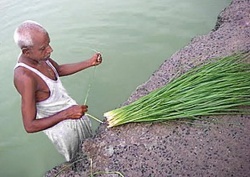Kusha grass
Kusha grass (Poa cynosuroides) — a variety of grass considered sacred in India. The Buddha used this grass to make the meditation seat on which he attained enlightenment under the bodhi tree. For this reason it has a particular symbolic significance in Buddhist practice and is used in various rituals.
Scientifically known as Desmostachya bipinnata, kusha grass has been used long since human history. It is an Old World perennial grass and is commonly known in English as Halfa grass, big cordgrass and salt reed grass. Kusha grass is grown in the temperate and tropical regions of Asia and is distributed throughout India. It is upto 2 feet in height and has a sharp pointy edge. For religious purposes the grass has to be plucked on a specific day and not on any other day. The kusha grass has significant uses in medicine and Hindu Vedic rituals.
Religious Uses of the Kusha Grass
The most religious connotation of the kusha grass is to use it as a purifying object. The ultimate purification method in Hindu religion being fire, kusha grass is used in sacrificial fire or yajna called Kushandika. Brahmins use this grass to sprinkle holy water during rituals. The person performing the ritual wraps a strand of grass around the ring finger and wears it as a ring. Kusha grass is also used to make ropes and mats, which are used by Brahmins to sit on during rituals and to encircle them and the deities to cast a ring of protection. Kusha grass is used as an edible during eclipse to absorb negative energies and the harmful radiation in the environment.
Medicinal Uses of the Kusha grass
Kusha grass is a traditional medicine used to treat urinary disorders, dysentery and menorrhagia. The extract of the grass is used in drinks for cooling effects during summer, the essence and oils of the grass also has the same effect.
Other Uses of the Kusha grass
The Kusha is used as fodder for livestock and is also used as a sand binder to prevent soil erosion.
Myth regarding the Kusha Grass
In Vedic literature like the Puranasand the Upanishads it is described that the kusha grass came into existence during the Samundra Manthan, churning of the cosmic seas. When the gods and demons got ready to churn the cosmic ocean there was nothing to support the base of the Madhara Mountains. So, Lord Vishnu assumed the form of the Cosmic Tortoise (Kurma Avatar) and the shell of the tortoise gave the needed support. During the churning, the hairs of the tortoise rubbed off and were washed ashore and became Kusha. When Amrita, the nectar of immortality was finally achieved, few drops of it fell accidentally on the Kusha grass thus imbuing it with healing properties. The serpents around wanted a taste of this elixir and ended up licking the leaves, but they were so sharp that the serpent’s tongue were sliced in two.
The Kusha grass with all its healing potency and religious uses is grown on low-lying marshy regions and is available all over India.
